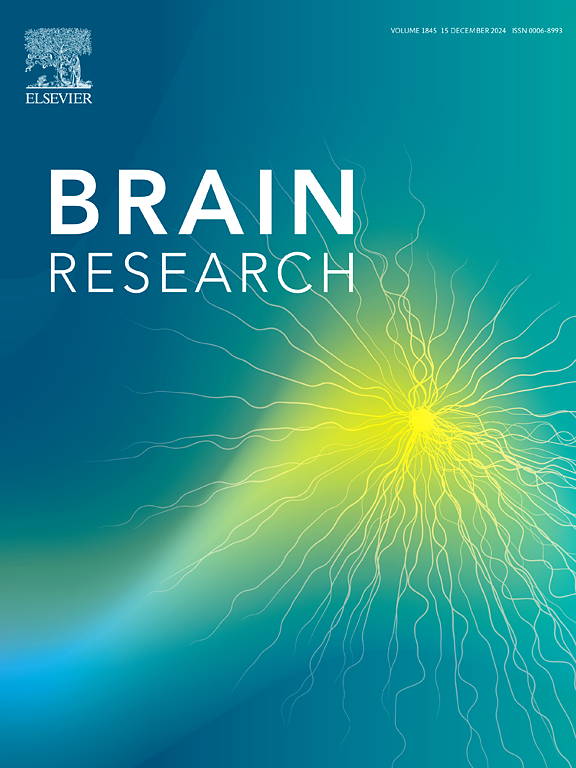杏仁核和海马中的 AMPA 受体功能亢进有助于增强糖尿病小鼠的恐惧记忆。
IF 2.6
4区 医学
Q3 NEUROSCIENCES
引用次数: 0
摘要
糖尿病患者焦虑等精神疾病的发病率较高。我们曾报道,糖尿病小鼠的恐惧记忆(一种与焦虑相关的模型,反映在冻结反应中)会增强,而 AMPA 受体拮抗剂可改善恐惧记忆。本研究调查了链脲佐菌素(STZ)诱导的糖尿病小鼠杏仁核和海马中 AMPA 受体的功能是否发生了改变。虽然杏仁核和海马中 AMPA 受体 GluA1 亚基的蛋白水平未发生变化,但 STZ 诱导的糖尿病小鼠杏仁核和海马中丝氨酸 845 磷酸化的 GluA1 蛋白水平以及海马中丝氨酸 831 磷酸化的 GluA1 蛋白水平均有所增加。在 STZ 诱导的糖尿病小鼠的杏仁核和海马中增加的 L-乳酸不会改变这两个脑区的蛋白质水平。相反,STZ 诱导的糖尿病小鼠的杏仁核和海马中磷酸化蛋白激酶 A(PKA)催化亚基和磷酸化钙调蛋白激酶 II(CaMKII)的蛋白水平都有所升高,而磷酸化蛋白激酶 A(PKA)催化亚基和磷酸化钙调蛋白激酶 II(CaMKII)可分别使 GluA1 的丝氨酸 845 和丝氨酸 831 磷酸化。在恐惧记忆测试中,在测试前注射 PKA 抑制剂 H-89 和在条件反射或测试前注射 CaMKII 抑制剂 KN-62 可分别降低 STZ 诱导的糖尿病小鼠冻结的增加。这些结果表明,由于PKA和CaMKII的磷酸化增加,杏仁核和海马中的AMPA受体功能增强,从而增强了糖尿病小鼠的恐惧记忆。本文章由计算机程序翻译,如有差异,请以英文原文为准。
Hyperfunction of AMPA receptors in the amygdala and hippocampus contributes to enhanced fear memory in diabetic mice
Patients with diabetes mellitus show an elevated prevalence of psychiatric disorders such as anxiety. We have reported that fear memory, a model related to anxiety as reflected in the freezing response, is enhanced in diabetic mice and was ameliorated by an AMPA receptor antagonist. The present study investigated whether functions of AMPA receptors in the amygdala and hippocampus are altered in streptozotocin (STZ)-induced diabetic mice. While protein levels of the GluA1 subunit of AMPA receptors were not altered in the amygdala and hippocampus, protein levels of GluA1 phosphorylated at serine 845 in the amygdala and hippocampus and of GluA1 phosphorylated at serine 831 in the hippocampus were increased in STZ-induced diabetic mice. L-lactate, which is increased in the amygdala and hippocampus of STZ-induced diabetic mice, did not alter these protein levels in either brain area. In contrast, protein levels of phosphorylated protein kinase A (PKA) catalytic subunit and phosphorylated calcium calmodulin kinase II (CaMKII), which are known to phosphorylate serine 845 and serine 831 of GluA1, respectively, were increased in the amygdala and hippocampus of STZ-induced diabetic mice. In the fear memory test, the PKA inhibitor H-89 injected before test sessions and the CaMKII inhibitor KN-62 injected before conditioning or test sessions each reduced the increase in freezing in STZ-induced diabetic mice. These results indicate that the functions of AMPA receptors in the amygdala and hippocampus are enhanced due to increased phosphorylation by PKA and CaMKII, which enhances fear memory in diabetic mice.
求助全文
通过发布文献求助,成功后即可免费获取论文全文。
去求助
来源期刊

Brain Research
医学-神经科学
CiteScore
5.90
自引率
3.40%
发文量
268
审稿时长
47 days
期刊介绍:
An international multidisciplinary journal devoted to fundamental research in the brain sciences.
Brain Research publishes papers reporting interdisciplinary investigations of nervous system structure and function that are of general interest to the international community of neuroscientists. As is evident from the journals name, its scope is broad, ranging from cellular and molecular studies through systems neuroscience, cognition and disease. Invited reviews are also published; suggestions for and inquiries about potential reviews are welcomed.
With the appearance of the final issue of the 2011 subscription, Vol. 67/1-2 (24 June 2011), Brain Research Reviews has ceased publication as a distinct journal separate from Brain Research. Review articles accepted for Brain Research are now published in that journal.
 求助内容:
求助内容: 应助结果提醒方式:
应助结果提醒方式:


